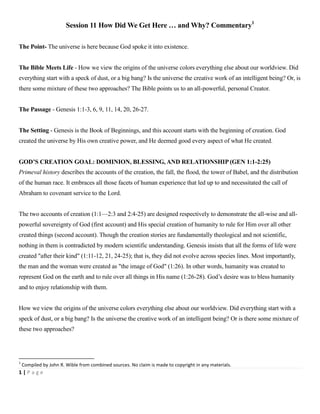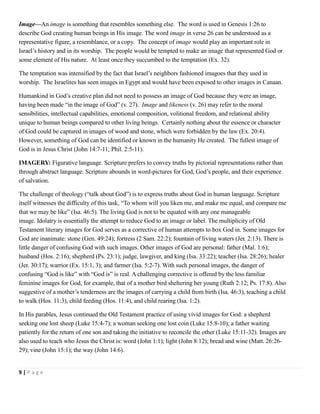- The universe exists because God spoke it into existence out of nothing according to the biblical creation account. How we view origins shapes our entire worldview.
- The Genesis creation story describes God bringing order from chaos over six days by speaking light, land, plants, stars, animals and humanity into being.
- Humanity is uniquely made in God's image to have dominion over creation and enjoy relationship with our Creator, explaining why we and the universe exist.










![A better definition of myth would be a “traditional story of ostensibly historical events that serves to unfold
part of the world view of a people or explain a practice, belief, or natural phenomenon.”2
The earliest civilizations that left written materials were Sumerian and Egyptian. One of the earliest creation
accounts is from Sumer and is called the “Eridu Genesis.” Eridu was one of the earliest known cities in
southern Mesopotamia.
The fragments of this creation account date to about 1600 BC. The mother goddess Nintur was portrayed as
instrumental in the creation of mankind; she said, “May they [the people] come and build cities and cult
places, that I may cool myself in their shade.”3 Humans being created to serve the gods was a common
theme in Mesopotamian and Egyptian myths. The “Epic of Atra-khasis,” a Babylonian creation story dated
to the seventeenth century BC, records that the gods were unhappy, because “the toil of the gods was great,
the work was heavy, the distress was much.”4 The solution of this problem was for the goddess Nintu
(referred to as Nintur in Sumeria), to create humanity. The goddess said, “I have removed your heavy work,
I have imposed your toil on man.”5 This seemed to be a good solution, until humankind became too noisy.
Enlil, one of the chief gods, then said, “The noise of humankind [has become too intense for me, with their
uproar] I am deprived of sleep.”6 The myth tells that eventually the gods caused a flood to destroy all
mankind, except Atra-khasis. The god Enki told Atra-khasis to build a boat to save his life.7
The “Epic of Atra-khasis” explained the creation of humanity as the work of the goddess Nintu and involved
the slaughter of a god named We-ila, whose blood was then mixed with clay. Nintu (also called “Mami”)
then uttered an incantation and used the clay to produce seven males and seven females. There is no
borrowing of any of this material by Moses in the Genesis creation account. Nintu‟s creation of man by clay
is nothing like the creation of man from the dust of the ground recorded in Genesis. Of course, the “Epic of
Atra-khasis” does mention a great flood. It was a flood of total destruction, except for Atra-khasis and those
with him in his boat. Nintu came to regret causing the flood saying, “How did I, with them, command total
destruction?”9
Genesis accurately records God flooding the earth. Many ancient cultures retained some knowledge of a
great flood and incorporated it into their myths. The few similarities between the Genesis account of the
flood and the flood account in the “Epic of Atra-khasis” pale, however, in comparison to the differences.
The Epic of Atra-khasis reveals supposed deities who made bad decisions and came to recognize their
mistakes. The biblical account of the flood indicates that God was completely righteous in bringing a flood
upon the earth.
While the similarities of ancient Near Eastern creation myths with the creation account in the Book of
Genesis are interesting, the differences between these accounts are striking. The Book of Genesis places
man at the apex of God‟s creation; humanity is made in the image of God; and he is placed in authority over
the garden. Mesopotamian accounts of creation make mankind the servants of the gods, so the gods do not
have to work so hard. The cause of the flood in the biblical account is humanity‟s sinfulness; the
Mesopotamian accounts attribute the flood to the arbitrary and capricious nature of the gods.10
11 | P a g e](https://image.slidesharecdn.com/ss-140215213610-phpapp02/85/Ss-02-16-14-gen-1-creation-commentary-11-320.jpg)
![Many other striking differences are also present, leading one scholar to write, “It is difficult to discuss
comparisons between Israelite and Mesopotamian literature concerning creation of the cosmos because the
disparity is so marked.”11
Although Egyptian creation myths have some occasional similarities to the biblical account of creation,
many striking differences are evident. The existing text of the Egyptian creation story called “The Theology
of Memphis” dates to 700 BC; the original text likely dates to about 2700 BC. The story contains the
statement that by the work of the god Ptah “all the divine order really came into being through what the heart
thought and the tongue commanded.”12 Such a statement is reminiscent of the Genesis creation account
where God spoke the world into existence.
However, beyond that similarity the Egyptian creation story is radically different. “The Theology of
Memphis” depicts the god Ptah as first crating the Ennead, which perhaps was a council of gods (who were
then, involved in further creative acts). How these gods came into being is described differently in different
texts. “His [Ptah‟s] Ennead is before him in (the form of) teeth and lips. That is (the equivalent of ) the
semen and the hands of Atum. Whereas the Ennead of Atum came into being by his semen and his fingers,
the Ennead (of Ptah), however, is the teeth and lips in his mouth, which pronounced the name of
everything.”13 Such a crude depiction of creation diverges starkly from the biblical account. God did not
create lesser deities who then created even lesser things. Rather, God created all things, forming humanity
specially in His own image.
The Egyptian myths are not the only ones that contain crude and vulgar actions on the part of the gods. The
Sumerian myth that supposedly tells about a loss of paradise is named “Enki and Ninhursag.”14 Some
scholars have suggested that the story is not really about a loss of paradise, but that the place named Dilmun
in the story is “a virginal and inchoate place, lacking life, fresh water, and human culture.”15 In the story,
Enki, the god of wisdom, incestuously fathered a series of goddesses. He first had relations with Ninhursag,
then with their daughter Ninmu, then with Ninkurra, his daughter with Ninmu, and so forth.16 Nowhere in
the story is there any hint of any immorality on the part of the god Enki. The Book of Genesis does record
incestuous relationships, like that of Lot with his daughters, but such events are clearly indicated as being
immoral.
An Akkadian account of creation, the “Enuma Elish,” also known as the “Epic of Creation,” dates to the
eleventh century BC.17 The most notable similarity between it and the Genesis account of creation is the
mention of two spheres of water in Genesis created by God, and the mention of Marduk splitting the carcass
of the dead goddess Tiamat into two halves, with on half constituting the earth and the other the sky.
Furthermore, the name Tiamat is linguistically related to the Hebrew word tehom, the “deep.” Yet, any
minor similarities are greatly dwarfed by the great disparity between the accounts. According to one modern
scholar the theory that the Babylonian Marduk could create the heavens and earth by splitting the dragon
goddess Tiamat into two halves is so preposterous that “no one but a lunatic under the influence of hashish
could ever arrive at the theory.”18
12 | P a g e](https://image.slidesharecdn.com/ss-140215213610-phpapp02/85/Ss-02-16-14-gen-1-creation-commentary-12-320.jpg)





